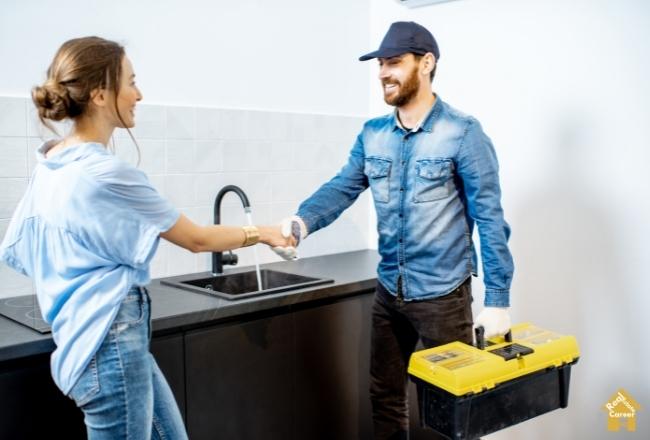(**) Disclosure: This post may contain affiliate links, meaning RealEstateCareerHQ.com will get a commission if you decide to make a purchase through the links, but at no additional cost to you.
Plumbing is an important trade as the work may impact the health and safety of the community. The role of plumbers includes installing and maintaining systems used for water, sewage, and drainage. Plumbers are responsible for ensuring that these systems are installed correctly and function properly.
According to the U.S. Bureau of Labor and Statistics (May 2021), nationally speaking, the job outlook of plumbers is projected to grow at 5% from 2020 to 2030. California has 40,400 plumbers, the most of any state.
So you’re interested in a plumbing career in California? That’s great, this is the perfect guide for you!
In California, all plumbers are required to obtain a Plumbing Class C Specialty license from the California Contractors State License Board.
To become a licensed plumber in California, an applicant must be at least 18 years old, hold a high school diploma, obtain work experience under the supervision of a licensed contractor or 4 years of documented journeyman experience on jobs valuing $500 or less. Applicant must also pass the Trade and Law& Business Exam, and submit an application and fees to the California Contractors State License Board.
In this guide, you will learn about the steps to obtaining a plumbing license in California. You will also find income updates, education programs, and FAQs on this profession.
So read on to learn more about what it takes to launch your plumbing career!
7 Steps to Become a Licensed Plumber in California

Step 1: Meet the eligibility requirement
You must be at least 18 years old and have a high school diploma or its equivalent GED.
As you can imagine, there will be lots of measuring and gauging while working in the field. Therefore, having good math skills such as geometry, algebra, and metric measurements is certainly an asset.
Also, a strong understanding of science is necessary to understand how plumbing systems work. Physics, chemistry, and thermodynamics are particularly important for those who want to enter this field.
Step 2: Obtain plumbing-related education or training
Now, it’s time to equip yourself with the technical skills and knowledge required for the job. The Licensing Board requires you to obtain 4 years of journeyman-level experience in the field within the last 10 years.
You may obtain those experience by completely by working in the field. All experience must be verified by a qualified person, that is someone who can prove you have really done the work.
“The certifier can be an employer, fellow employee, journeyman, union representative, contractor, business associate, or a client if the applicant is/was self-employed.“
California Contractors State License Board
The certifier must also complete the experience certification portion of the application.
Alternatively, you may take a training program in an approved college or vocational. These training program can be credited toward up to three years of experience, then you may accompany at least one year working in the field.
The curriculum should cover topics such as draining, venting, pipe cutting & soldering, water heating systems, the local plumbing codes, and electrical basic.
The advantage of going through an apprentice program is that you’ll learn about a plumber’s day-to-day tasks through on-the-job training.
I just did some online researches, California Apprenticeship Coordinators Associations is one of the organizations that offer apprenticeship program. Also, the California’s Department of Industrial Relations has a database of an apprenticeship program available.
Here are a few trade schools that offer certificate programs:
- Plumbing-Heating-Cooling-Contractors Association of California
- United Association: Union of Plumbers, Fitters,
- Welders, & Service Techs,
- Foothill College
Step 3: Pass the California Plumbing (C-36) Exam

The purpose of the plumber journeyman exam is to ensure that the person who holds this license has the necessary skills and knowledge to safely and effectively install and repair plumbing systems.
The California Plumbing (C-36) exam consists both “Trade” portion and the “Law & Business” portion. It is a closed-book exam with multiple-choice questions.
Content of the California Plumbing Trade Exam
| Exam Topics | Approximate Weighting |
|---|---|
| Planning and Estimating | 22% |
| Underground and Rough Systems | 24% |
| Finish Plumbing Installations | 18% |
| Service, Repair, and Remodel Plumbing Systems | 19% |
| Safety | 17% |
Content of the California Law & Business Exam
| Exam Topics | Weighting (Approximate) |
|---|---|
| Business Organization and Licensing | 13% |
| Business Finances | 15% |
| Employment Requirements | 20% |
| Insurance and Liens | 12% |
| Contract Requirements and Execution | 21% |
| Public Works | 5% |
| Safety | 14% |
Sample Questions of the California Plumbing Exam
- What type of wall fitting should a contractor use to install a wall-mounted water closet?
a. A hubless closet ring
b. An approved spud fitting
c. An approved closet flange
d. An approved carrier fitting*
- What is the total charge for four 8-hour days’ use of a backhoe, if the cost for rental is $400 per day and the operator cost is $70 per hour?
a. $5,440
b. $3,840*
c. $2,640
d. $2,160 - When installing a water filtration system for domestic use, what agent is commonly used for taste and odor control?
a. Lime
b. Carbon*
c. Nitrogen
d. Copper sulphate
Above are sample questions from Contractors State License Board License Examination Study Guide (Plumbing C-36)
Furthermore, you also need to pass the asbestos exam. This is an open-book online exam.
The purpose is to make sure plumbers are aware of the risks of dealing with asbestos and can equip with sufficient knowledge in responding appropriately to construction situations where asbestos is or may be present.
Step 5: Apply for the California Contractor License
Now that you’ve completed all the requirements, you can apply for a “Plumber C-36” license from the California State License Board. To do so, you’ll submit a license application along with relevant documents. There’s an application fee of $330.
In the application, you would provide your personal info: education, technical courses, apprenticeship, experience, examination scores.
Since the Licensing Board has the responsibility to protect the public interest, they will also require you to disclose if there have been any disciplinary actions against your professional or trades license. You are also required to go through a background check.
If you have any questions, you may contact the California State License Board at (800) 321-CSLB (2752).
Step 6: Provide insurance and surety bond
All contractor licensee must provide evidence of workers’ compensation insurance. You may find out more on the Workers’ Compensation Insurance here.
Furthermore, you need to get a $15,000 surety bond. The purpose of the bond is to protect the state and the public in case you violate the plumbing code or cause damage to someone’s property or injuries to other people.
But keep in mind that this is not insurance to protect you. If you are looking for coverage to protect your plumbing practice, you should consider getting E&O insurance.
Step 7: Renew the plumbing license
All California Plumbers must to renew their license every two years. Here’s the renewal form. The renewal fee is $450.
Although there is no continuing education requirement to renew the plumbing contractor license, it is important to stay informed about the latest changes on technology and regulations.
FAQ on being a plumber in California

How much do plumbers make in California?
According to the Bureau of Labor Statistics (May 2021), plumbers, pipefitters and steamfitters in California make an average yearly income of $62,390 with an average hourly wage of $34.62. The income range typically ranges between $93,090 and $93,090. Top earning plumbers in California make over $120,720.
Your earning ability as a plumber is subjected to many variables such as your experience, licensing level, the type of properties you specialize, the company size, its location, and most importantly, the amount of effort you are willing to put into this career.
How long does it take to become a plumber in California?
It takes at least four years to become a licensed plumber in California. That is the minimum period to fulfill the work experience requirement. The duration would also depend on how long you complete the apprenticeship program, and pass the state-required exam.
How much does it cost to become a plumber in California?
It costs $530 to become a licensed plumber in California. This includes the application fee ($200) and license fee ($330).
In addition to the above, there will be other expenses such as tuition, E&O insurance, and plumbing equipment. Some companies may pay or reimburse you if you work as their employee. But if you are running your own practice, these are the cost you need to account for yourself.
Which states have plumbing license reciprocity with California?
California has reciprocity agreement with Arizona, Louisiana, and Nevada.
(**) Affiliate Disclosure: Please note that some of the links above are affiliate links, and at no additional cost to you. Our company, JCHQ Publishing will earn a commission if you decide to make a purchase after clicking on the link. Please understand that we include them based on our experience or the research on these companies or products, and we recommend them because they are helpful and useful, not because of the small commissions we make if you decide to buy something through the links. Please do not spend any money on these products unless you feel you need them or that they will help you achieve your goals.
Disclaimer: The information in this post is for general information only, and not intend to provide any advice. They are subjected to change without any notice, and not guaranteed to be error-free. Some of the posts on this site may contain views and opinions from individual not related to JCHQ Publishing. They do not necessarily reflect our view or position.
Reference:

